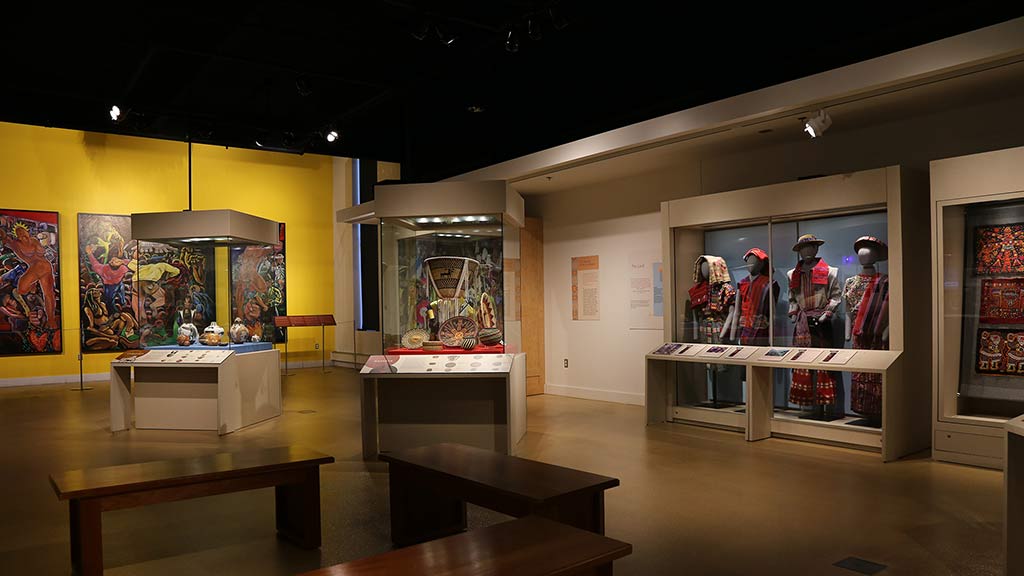
New Americas Module: The La Casa Cultural Latina and Department of Latina/Latino Studies Mural Panels
- Post Date: 2/22/2020
- Author: Beth Watkins, education and publications coordinator
- Reading Time: 6 minute read
The mural located at 510 East Chalmers, formerly the home of the Department of Latina/Latino Studies and La Casa Cultural Latina, symbolizes the struggle of Latina/o/x students. It was created in two separate periods (1974–5 and 2004) under the direction of artist Oscar Martínez and with assistance of students during those periods.
La Casa Cultural Latina, the first Latino Cultural Center on campus, was opened in 1974 but was almost immediately threatened with demolition. Drawing on organizational strategies developed in home communities, Martínez and other students defined their claim to the space by painting a mural to cover the house’s front room.
In many Latin American communities, communally produced murals serve as markers and acts to claim ownership of contested space. The mural represents the processes of activism and community building of Latina/o/x students beginning in the 1960s, while also celebrating Latin American cultures and education as a vehicle for prosperity and knowledge.
La Casa Cultural Latina moved into a new facility in 1995. Eight years later students fought for and gained support from the University administration to have Oscar Martínez return to campus to renovate and complete the mural in 2004. The original La Casa facility was the home to the Department of Latina/Latino Studies from 1996 until 2013.
About the Artist
Through the study of science and art at the University of Illinois in 1977, Oscar Martínez received a BS in Medical Art from the University of Illinois Medical Center. Mr. Martínez is an accomplished artist who has had numerous group and solo exhibitions throughout the Caribbean, Mexico, and the southeastern and midwest regions of the United States.
Other artists of the mural include Gloria de Jesús, Rosa de León, Herminia Díaz, Ralph Enrique, María González, Roberto Hernández, Madilyn Lamb, Olga López, Luz Martínez, Pedro Martínez, Vicky Nodal, Flavio Parra, Felipe Rodríguez, Vicente Torres, and Michael Zaloudek.
More segments of the mural are on display at the Illini Union.
Funding and support for the conservation of the mural panels came from the Office of the Chancellor, the Office of the Provost, the Office of the Vice Chancellor for Student Affairs, the Office of the Vice Chancellor for Diversity, Equity & Inclusion, the College of Liberal Arts and Sciences, the Office of Facilities and Services, the Spurlock Museum, the Department of Latina/Latino Studies, and La Casa Cultural Latina.
Nuevo módulo de las Américas: El Mural de La Casa Cultural Latina y el Departamento de Estudios Latina/os
La Casa Cultural Latina, el primer Centro Cultural Latino en el recinto universitario fue inaugurado en 1974, pero casi inmediatamente amenazado con la demolición. Basándose en estrategias organizativas desarrolladas en comunidades de origen, Martínez y otros estudiantes definieron su reclamación del espacio al pintar un mural para cubrir la sala principal de la casa.
En muchas comunidades latinoamericanas, los murales comunalmente producidos sirven como marcadores y actos de reclamación de propiedad de espacios impugnados. El mural representa los procesos de activismo y construcción comunitaria impulsada por estudiantes Latina/o/x en la década de 1960, mientras que también celebra la cultura latinoamericana y la educación como un vehículo para la prosperidad y el conocimiento.
La Casa Cultural Latina se mudo a una nueva instalación en 1995. Ocho años más tarde, los estudiantes lucharon y obtuvieron el apoyo de la administración universitaria para que Oscar Martínez regresara a renovar y completar el mural en el 2004. El establecimiento original de La Casa se convirtió en el hogar del Departamento de Estudios Latina/os desde 1996 hasta 2013.
Sobre el Artista
Por medio de sus estudios de la ciencia y el arte, Oscar Martínez recibió una licenciatura en Arte Médico del Centro Medico de la Universidad de Illinois en 1977. El señor Martínez es un artista consumado que ha tenido numerosas exposiciones colectivas e individuales por todo el Caribe, México, y en las regiones del sudoeste y medio oeste de los Estados Unidos.
Otros artistas que colaboraron en el mural incluyen a Gloria de Jesús, Rosa de León, Herminia Díaz, Ralph Enrique, María González, Roberto Hernández, Madilyn Lamb, Olga López, Luz Martínez, Pedro Martínez, Vicky Nodal, Flavio Parra, Felipe Rodríguez, Vicente Torres, y Michael Zaloudek.
Otros segmentos del mural están en exhibición en la Illini Union.
La financiación y apoyo para la conservación del mural provino de la Oficina del Canciller, la Oficina del Rector, la Oficina del Vicecanciller de Asuntos Estudiantiles, la Oficina del Vicecanciller para la Diversidad, Equidad e Inclusión, el Colegio de Artes y Ciencias Liberales, la Oficina de Instalaciones y Servicios, el Museo Spurlock, el Departamento de Estudios Latina/os, y La Casa Cultural Latina.
-
- Share:
- Subscribe to Newletter
- Giving

